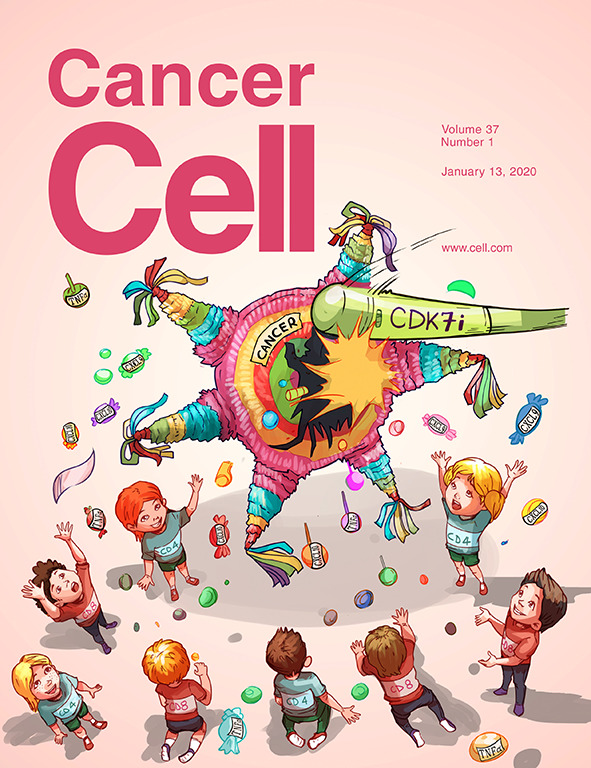一种CXCR4部分激动剂通过靶向免疫抑制性中性粒细胞和癌症驱动的粒细胞生成来改善免疫治疗
IF 44.5
1区 医学
Q1 CELL BIOLOGY
引用次数: 0
摘要
病理激活的免疫抑制中性粒细胞损害肿瘤免疫治疗效果。趋化因子受体CXCR4是造血和中性粒细胞生物学的中心调节因子,是一个有吸引力的靶标。在此,我们将分泌的CXCR4部分受体兴奋剂三叶因子2 (TFF2)融合到小鼠血清白蛋白(MSA)中,并证明TFF2-MSA肽与抗pd -1协同抑制原发肿瘤生长和远处转移,并延长胃癌(GC)小鼠模型的生存期。利用组氨酸脱羧酶(Hdc)-GFP转基因小鼠在体内追踪多形核髓源性抑制细胞(PMN-MDSC),我们发现TFF2-MSA选择性地降低Hdc-GFP+ cxcr4高免疫抑制中性粒细胞,从而促进CD8+ T细胞介导的抗pd -1杀伤肿瘤。重要的是,与CXCR4拮抗剂相比,TFF2-MSA可减少骨髓颗粒生成,而CXCR4拮抗剂不能带来治疗效果。在GC患者中,CXCR4+LOX-1+低密度中性粒细胞升高与循环TFF2水平降低相关。总的来说,我们的研究引入了一种利用CXCR4部分激动作用的策略,通过靶向免疫抑制性中性粒细胞和粒细胞生成来恢复抗pd -1敏感性。本文章由计算机程序翻译,如有差异,请以英文原文为准。

A CXCR4 partial agonist improves immunotherapy by targeting immunosuppressive neutrophils and cancer-driven granulopoiesis
Pathologically activated immunosuppressive neutrophils impair cancer immunotherapy efficacy. The chemokine receptor CXCR4, a central regulator of hematopoiesis and neutrophil biology, represents an attractive target. Here, we fuse a secreted CXCR4 partial agonist, trefoil factor 2 (TFF2), to mouse serum albumin (MSA) and demonstrate that TFF2-MSA peptide synergizes with anti-PD-1 to inhibit primary tumor growth and distant metastases and prolongs survival in gastric cancer (GC) mouse models. Using histidine decarboxylase (Hdc)-GFP transgenic mice to track polymorphonuclear myeloid-derived suppressor cell (PMN-MDSC) in vivo, we find that TFF2-MSA selectively reduces the Hdc-GFP+CXCR4high immunosuppressive neutrophils, thereby boosting CD8+ T cell-mediated tumor killing with anti-PD-1. Importantly, TFF2-MSA reduces bone marrow granulopoiesis, contrasting with CXCR4 antagonism, which fails to confer therapeutic benefits. In GC patients, elevated CXCR4+LOX-1+ low-density neutrophils correlate with lower circulating TFF2 levels. Collectively, our studies introduce a strategy that utilizes CXCR4 partial agonism to restore anti-PD-1 sensitivity by targeting immunosuppressive neutrophils and granulopoiesis.
求助全文
通过发布文献求助,成功后即可免费获取论文全文。
去求助
来源期刊

Cancer Cell
医学-肿瘤学
CiteScore
55.20
自引率
1.20%
发文量
179
审稿时长
4-8 weeks
期刊介绍:
Cancer Cell is a journal that focuses on promoting major advances in cancer research and oncology. The primary criteria for considering manuscripts are as follows:
Major advances: Manuscripts should provide significant advancements in answering important questions related to naturally occurring cancers.
Translational research: The journal welcomes translational research, which involves the application of basic scientific findings to human health and clinical practice.
Clinical investigations: Cancer Cell is interested in publishing clinical investigations that contribute to establishing new paradigms in the treatment, diagnosis, or prevention of cancers.
Insights into cancer biology: The journal values clinical investigations that provide important insights into cancer biology beyond what has been revealed by preclinical studies.
Mechanism-based proof-of-principle studies: Cancer Cell encourages the publication of mechanism-based proof-of-principle clinical studies, which demonstrate the feasibility of a specific therapeutic approach or diagnostic test.
 求助内容:
求助内容: 应助结果提醒方式:
应助结果提醒方式:


